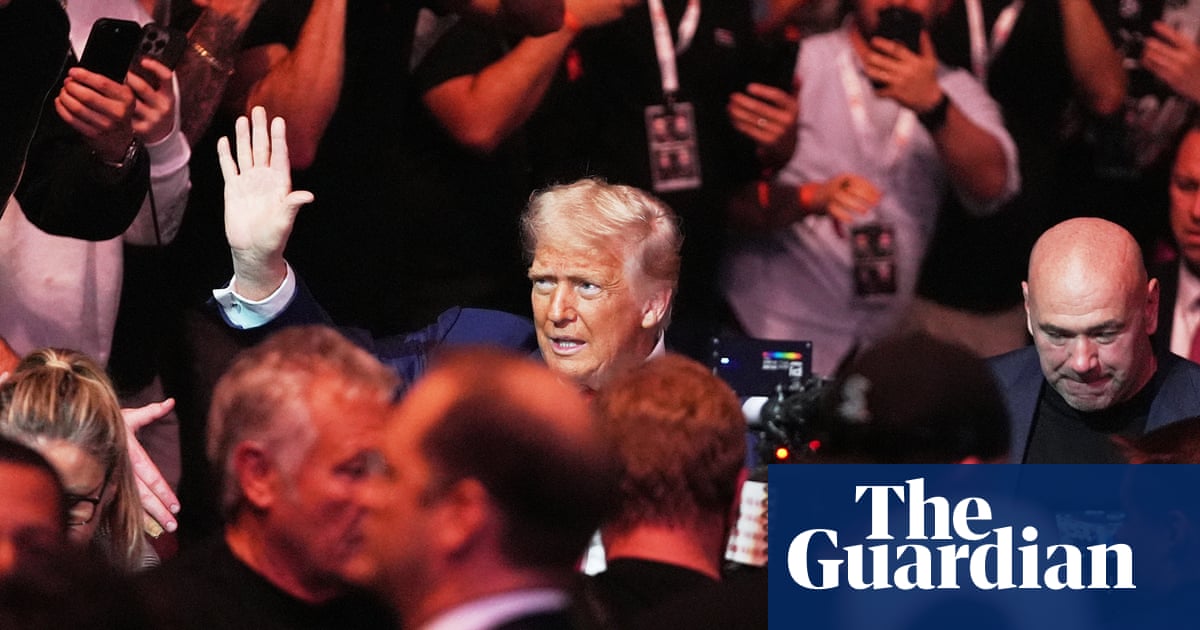Donald Trump walked out toa thunderous standing ovationas Kid Rock’s “American Bad Ass” boomed from the sound system. He watched martial artists slug it out behind a chain-link fence. A female champion let the US president try on her gold belt. It was a night of machismo, spectacle and violence.
Shortly before he joined an Ultimate Fighting Championship (UFC) event in Newark, New Jersey, on Saturday night, Trump hadsigned an orderdeploying 2,000 national guard troops to Los Angeles, where protests sparked by sweeping immigration raids led to clashes between authorities and demonstrators.
The White House said Trump was sending in the guardsmen to “address the lawlessness that has been allowed to fester” in California. Governor Gavin Newsom, a Democrat, said the move was “purposefully inflammatory and will only escalate tensions”. Experts said it was the first time in 60 years that a president has activated astate’s national guard– a reserve military – without a request from its governor.
Critics also saw it as an authoritarian flex by a strongman president who has relentlesslytrampled norms and burst through guardrails. Since returning to office in January, Trump has sought to crush dissent at cultural institutions, law firms, media companies and universities. Many believed it was only a matter of time before he took the fight to the streets.
The protests against Immigration and Customs Enforcement (Ice) raids present him with an antagonist that can be used as a focal point for anger, hatred and fear, ensuring that dissent is redirected away from the government and toward “an enemy within”. Trump is the master of distraction and, with the help of lurid rightwing media clips, wants to divert attention from policy failures and hisugly feud with Elon Musk.
Chris Murphy, a Democratic senator,tweeted: “Important to remember that Trump isn’t trying to heal or keep the peace. He is looking to inflame and divide. His movement doesn’t believe in democracy or protest – and if they get a chance to end the rule of law they will take it. None of this is on the level.”
As with much else in his scorched earth second term, Trump advertised this in advance. Last Octoberhe told Fox News: “I always say, we have two enemies. We have the outside enemy, and then we have the enemy from within, and the enemy from within, in my opinion, is more dangerous than China, Russia and all these countries.”
He added: “We have some very bad people. We have some sick people. Radical left lunatics I think it should be very easily handled by, if necessary, by National Guard, or if really necessary, by the military, because they can’t let that happen.”
There are echoes of 2020 when Trump used national guard troops in Washington toquell Black Lives Matter proteststhat arose after George Floyd was killed by Minneapolis police officers. The troops fired teargas to clear peaceful protesters from Lafayette Square near the White House to allow Trump to stage a photo-op at a church.
The former defense secretary Mark Esperlater revealedthat Trump asked about the protesters: “Can’t you just shoot them?Just shoot them in the legs or something?”
Trump and his rightwing allies have been busy rewriting the history of 2020 as a flashpoint when rioters brought carnage to US cities. Yet their narrative omits Trump’s conspicuous failure to active the national guard in response to his supporters’ attempt to overturn his election defeat bylaying siege to the US Capitolon January 6 2021.
Cory Booker, a Democratic senator for New Jersey, told NBC’s Meet the Press programme on Sunday: “We are now at a point where we have a president who sat back and did nothing as people stormed our Capitol, viciously beat police, and then when those people – who viciously beat police and led to some of their deaths, therefore cop killers – were convicted by juries, he then pardoned them all.
“So for him to be talking to anybody right now about responsible law enforcement to protect people is hypocritical at best.”
Now California – a Democrat-dominated state regularly invoked by Trump and his allies as a hive of “wokeness” and immigration lawlessness – is the ideal target for Trump to whip up the fervor and resentments of his base. The government is deploying the national guard “not because there is a shortage of law enforcement, but because they want a spectacle,”Newsom wrote on social media. “Don’t give them one.”
In a sign of how much has changed from his first term, there are no Mark Espers to push back this time. Instead the current defense secretary, Pete Hegseth, threatened to involve regular military forces, writing that active duty Marines at Camp Pendleton were on high alert and would also be mobilized “if violence continues”.
And Stephen Miller, a White House deputy chief of staff and architect of Trump’s draconian immigration crackdown,posted messagessuch as “We will take back America” and “Insurrection” – the latter raising the spectre of Trump invoking the Insurrection Act, one of the most powerful emergency powers at the disposal of a president.
The 18th-century wartime law would allow Trump to deploy the military on US soil against civilian protests, evoking parallels with autocratic regimes around the world that declare martial law. Again, the president has teed up a preview: on Saturday tanks will roll on the streets of Washingtonfor a paradeto celebrate the 250th anniversary of the US army.
It also happens to be Trump’s birthday.
